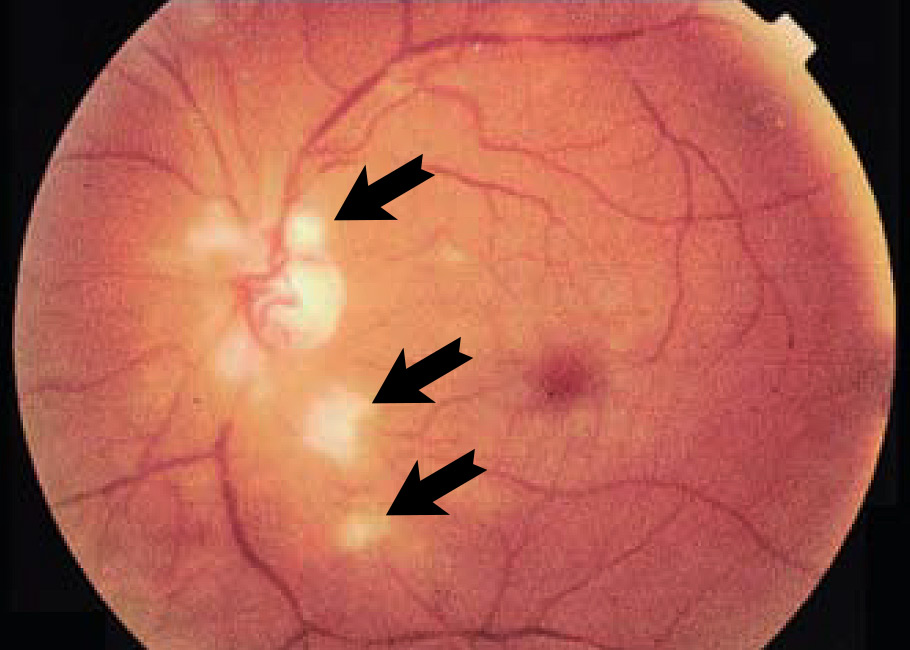Cotton wool spots are patches at the back of your eye. To healthcare providers, they look lighter-colored and fluffy, like absorbent cotton. These patches aren’t dangerous, but can be an early warning sign of conditions like high blood pressure or diabetes. If you know you have them, you can get a head start on preventing future complications.
Advertisement
Cleveland Clinic is a non-profit academic medical center. Advertising on our site helps support our mission. We do not endorse non-Cleveland Clinic products or services. Policy

Cotton wool spots are puffy, white areas on the retinas at the back of your eyes. Cotton wool spots aren’t something you can feel or see yourself, although they may cause a temporary blind spot (scotoma). The only way your healthcare provider can see them is by using the proper tools.
Advertisement
Cleveland Clinic is a non-profit academic medical center. Advertising on our site helps support our mission. We do not endorse non-Cleveland Clinic products or services. Policy
Cotton wool spots get their name because they look like absorbent cotton. This material is better known under the term “cotton wool” in the United Kingdom. In the United States, absorbent cotton is commonly called “cotton balls” (or “cotton bolls,” for the boll part of the cotton plant, where the fibers come from).
Cotton wool spots happen when there’s swelling, damage or other changes to the retina tissue that lines the back of your eye. The affected areas look puffy and lighter-colored than the surrounding tissue. They look like tufts of cotton when viewed directly by an ophthalmoscope.
Many conditions can cause this kind of change in retinal tissue. They tend to fall under the following categories:
Advertisement
In some cases, there’s no detectable cause of cotton wool spots. When that happens, the cause is idiopathic (unknown).
Medical professionals can look at your retinas using a handheld instrument called an ophthalmoscope. This tool allows a provider to look at the retinal tissue at the back of your eye. Providers commonly use it during a physical or eye exam. Cotton wool spots are also visible during a slit lamp exam, which lets a provider look at the back of your eye with special lighting and magnification.
There’s no way to treat cotton wool spots directly. Treating whatever’s causing them is the only way to resolve them. When the underlying causes are treatable and reversible, cotton wool spots are usually a short-term issue. They usually go away within six to 12 weeks.
Because so many different conditions and events can cause them, the treatments vary widely. Your healthcare provider is the best source of information regarding treatment options and which are most likely to help you.
Cotton wool spots are a sign of conditions that affect your retinas. Without treatment, these conditions can further damage your retinas and cause them to become thicker or thinner in ways they shouldn’t. When those changes are severe enough, they can disrupt your vision.
But the effects of many of these conditions don’t stop there. Many of them have effects throughout your body, including effects that can be severe. Your healthcare provider is the best person to tell you the possible complications in your situation and what you can do to prevent or minimize them.
Many causes of cotton wool spots are preventable, but they happen unpredictably. Some things you can do to lower your risk of developing cotton wool spots include:
It’s normal to feel concerned or worried if your healthcare provider or eye care specialist sees cotton wool spots while looking into your eyes. These spots are usually an early sign of conditions like high blood pressure or Type 2 diabetes. Knowing about these conditions can help you act early to manage conditions, seek treatment or take other steps to protect your eye health and overall well-being.
Advertisement
Cleveland Clinic’s ophthalmologists and optometrists have the highest training available. We provide exams, vision correction and care for many eye conditions.

Last reviewed on 02/04/2025.
Learn more about the Health Library and our editorial process.